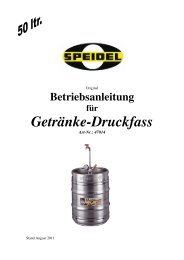Operating Instructions For Pressure Cask - Speidel Tank
Operating Instructions For Pressure Cask - Speidel Tank
Operating Instructions For Pressure Cask - Speidel Tank
You also want an ePaper? Increase the reach of your titles
YUMPU automatically turns print PDFs into web optimized ePapers that Google loves.
<strong>Pressure</strong> cask<br />
fruity beverage. Due to the constant tapping, the alcohol content will change slightly<br />
during the course of time. The freshness, however, will always remain.<br />
6.2 Low-alcoholic sweet cider<br />
<strong>For</strong> the operation of the pressure cask an additional gas set, a pressure relief valve (CO2),<br />
and a gas bottle (carbon dioxide) are required (see 'Accessories'). To operate the cask<br />
with a gas connection, please read the section "Filling the cask with gas properly".<br />
• When producing a non-alcoholic beverage, particular attention must be paid to<br />
hygiene and the quality of the fruit that is to be used. Never use spoiled fruit. The<br />
quality of the fruit juice depends on the grade and cleanliness of the fruit.<br />
• It is recommended to transfer the juice into another vessel after pressing and keep it<br />
there for 3 - 4 hours. This will remove the cloudiness from the juice.<br />
• Subsequently, fill the pressure cask immediately with the fresh and clean juice.<br />
• In order to prevent potential fermentation, add carbon dioxide at a pressure of 9 bar.<br />
Keep the gas bottle and all fittings connected to the pressure cask. When removing the<br />
gas bottle (see "Replacing the gas bottle"), it is normal that the pressure during CO2<br />
saturation is reduced (this is a natural reaction when carbonic acid forms in the<br />
beverage).<br />
• First, you will be left with a non-alcoholic fruit juice. During the course of time, the<br />
alcohol content may increase slightly inside the pressure cask, due to the repeated<br />
tapping. This is a natural process and cannot be completely remove without additives;<br />
however, the high pressure clearly slows down this process.<br />
• Please observe the following: The fresher the fruit, the longer you will be able to keep<br />
your juice non-alcoholic.<br />
6.3 Containers that keeps your fermented beverage fresh<br />
<strong>For</strong> the operation of the pressure cask an additional gas set, a pressure relief valve (CO2),<br />
and a gas bottle (carbon dioxide) are required (see 'Accessories'). To operate the cask<br />
with a gas connection, please read the section "Filling the cask with gas properly".<br />
• This procedure is widely used in the beverage industry. Carbon dioxide is used in<br />
many beverages. Today, even beer brewers and wine makers use carbon dioxide.<br />
Carbon dioxide effectively improves the quality of the beverage. During wine<br />
production, adding CO2 reduces the amount sulphurisation required.<br />
• Add any fermented beverage (wine, cider, beer, etc.) to you pressure cask.<br />
• Now, add carbon dioxide and pressurise the cask to 0.5 to 1 bar. The low pressure is<br />
sufficient to keep the beverage fresh. Keep the gas bottle and all fittings connected to<br />
the pressure cask.<br />
6.4 Soda water/carbonated mineral water<br />
<strong>For</strong> the operation of the pressure cask an additional gas set, a pressure relief valve (CO2),<br />
and a gas bottle (carbon dioxide) are required (see 'Accessories'). To operate the cask<br />
with a gas connection, please read the section "Filling the cask with gas properly".<br />
Page 9 of 16

















